Using reinforcement learning to improve drone-based inference of greenhouse gas fluxes
DOI:
https://doi.org/10.5617/nmi.9897Emneord (Nøkkelord):
reinforcement learning, data assimilation, drones, climate scienceSammendrag
Spatially representative mapping of greenhouse gas fluxes at the Earth’s surface is essential for the validation and calibration of climate models. We developed a framework to map surface fluxes with drones, using data assimilation for the inference of fluxes from drone-based observations, and reinforcement learning to optimize the drones’ sampling strategy. Herein, we show that a trained drone is able to quantify a CO2 hotspot more accurately than a drone flying a predefined intuitive sampling path that traverses the emission plume downwind from the source. We find that a concentration-based reward function updates the belief about the surface flux most towards the true value. A more general reward function based on information gain quantified by the Kullback-Leibler divergence shows potential for the future mapping of more complex surface flux fields, such as hotspots with different strengths, multiple hotspots at unknown locations, and jointly inferring different types of greenhouse gas fluxes.
Nedlastinger
Publisert
Versjoner
- 2023-08-15 (2)
- 2023-08-13 (1)
Utgave
Seksjon
Lisens
Opphavsrett 2023 Nordic Machine Intelligence

Dette verket er lisensiert under Creative Commons Attribution 4.0 International License.






